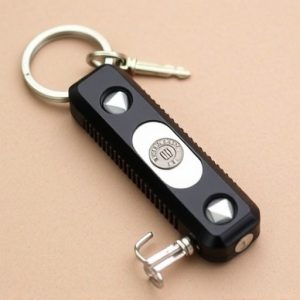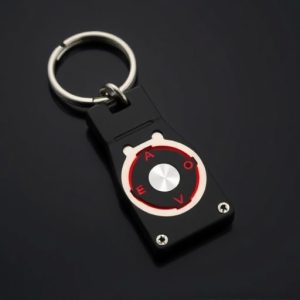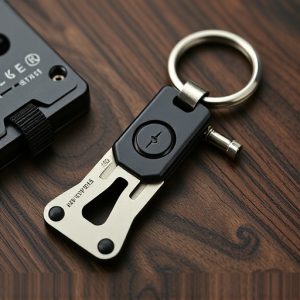Protective Keyring Devices: Legal Carry States & Self-Defense Tips
Understanding the legalities of carrying a keychain weapon requires knowledge of state-specific regu…….
Understanding the legalities of carrying a keychain weapon requires knowledge of state-specific regulations and definitions of "legal carry" weapons. The best keychain weapon striking points are critical areas designed for self-defense, balancing effectiveness with legal visibility and accessibility in public spaces. Selecting a model involves considering compactness, durability, grip, and additional utilities like flashlights or window breakers. Many US states have legalized compact, discreet keychain weapons, emphasizing responsible ownership through licensing and training. Safety features and proper training are crucial; the best striking points offer easy accessibility during distress while minimizing injury risk. Regular practice is vital to master self-defense skills for real-life application.
Protective keyring devices have emerged as a popular self-defense tool, offering discreet yet powerful protection. This article guides you through navigating legal carry regulations in various states while helping you choose the best keychain weapon for your needs. We explore striking points, design, and functionality. Additionally, safety features and practical applications are discussed, along with self-defense tips to ensure responsible use.
- Understanding Legal Definitions and Regulations
- Choosing the Best Keychain Weapon: Design and Functionality
- Key States Allowing Legal Carry of Protective Keyring Devices
- Safety Features and Training Recommendations
- Practical Applications and Self-Defense Tips
Understanding Legal Definitions and Regulations
When navigating the legal aspects of carrying a protective keyring device, understanding the specific definitions and regulations is paramount. Each state has its own laws governing concealed carry permits, including what constitutes a “legal carry” weapon. The term “best keychain weapon striking points” refers to the critical areas on a keyring device designed for self-defense, which must comply with local regulations without compromising functionality or legality.
Regulatory bodies typically define legal carrying as open and honest display of a protective device, ensuring it’s not easily concealable. This means understanding the dimensions, material, and overall design of your keyring device, focusing on striking points that are both effective for self-defense and meet the legal thresholds for visibility and accessibility in public spaces. Staying informed about these details is crucial to ensure compliance while enjoying peace of mind regarding personal safety.
Choosing the Best Keychain Weapon: Design and Functionality
When selecting a keychain weapon, understanding its design and functionality is paramount. The best keychain weapons are those that strike an optimal balance between compactness and effectiveness. Look for models with sharp, durable blades designed for quick deployment, ensuring they can be easily accessed in emergency situations. The handle should provide a firm grip, enhancing control during use.
Consider the overall build quality, opting for sturdy materials that guarantee longevity. Some keychains offer additional features like flashlights or windows breakers, providing multifaceted utility. Ultimately, the ideal choice will hinge on personal preferences and intended use cases, focusing on striking points that matter most for self-defense or survival scenarios.
Key States Allowing Legal Carry of Protective Keyring Devices
Many states in the US have recognized the importance of self-defense and have passed laws allowing the legal carry of protective keyring devices, often referred to as keychain weapons or self-defense tools. These compact and discreet devices are designed to offer a quick and effective means of protection against potential threats while also serving as a convenient everyday accessory.
Among the best keychain weapon striking points recognized by these states are areas that provide a strong grip and easy accessibility. Keychain knifes, for instance, often feature a tactical blade that can be deployed quickly with a simple flick of the wrist. Some models even incorporate other features like flashlights or pepper spray, enhancing their versatility in emergency situations. States like Texas, Florida, and California have been at the forefront of legalizing these devices, ensuring citizens have access to affordable and reliable self-defense options while promoting responsible ownership through licensing and training requirements.
Safety Features and Training Recommendations
When considering a protective keyring device for legal carry, understanding safety features and proper training is paramount. Such devices are designed to provide self-defense capabilities by offering strategic striking points accessible when in distress. The best keychain weapon should prioritize user safety, ensuring that it’s not only effective as a defense mechanism but also easy to control and minimize the risk of injury to both the user and potential assailants.
Training recommendations for legal carry states include practicing proper grip techniques, target acquisition drills, and understanding the device’s range limitations. Familiarizing yourself with local laws regarding self-defense tools is crucial before equipping yourself with a keychain weapon. Additionally, seeking professional training from certified instructors who specialize in personal defense can significantly enhance your ability to use the device effectively if needed.
Practical Applications and Self-Defense Tips
In practical applications, a protective keyring device can serve as more than just a convenient way to carry your keys. Many models incorporate sharp, durable edges designed for self-defense, making them useful tools in unexpected situations. The best keychain weapon striking points are typically located at the ends or along the sides of the keyring, offering options for both stabbing and slashing motions. These devices can provide a level of protection when facing threats, allowing users to defend themselves effectively in close quarters.
For self-defense tips, consider practicing proper hand positioning and aim. Hold the keyring firmly with one hand, using your thumb to steady the striking point. With your other hand, target vulnerable areas like eyes, throat, or groin—these are effective strikes that can incapacitate an assailant quickly. Remember, the goal is to cause pain and create an opportunity to escape, not to inflict severe injury. Regularly updating your skills through self-defense classes or practicing with a trusted partner can significantly enhance your ability to use a keyring device effectively in real-life scenarios.
When considering a protective keyring device for legal carry, it’s crucial to understand both state regulations and the unique features of these compact self-defense tools. By adhering to safety guidelines and training recommendations, users can effectively employ these devices’ striking points in real-world situations, ensuring personal safety while navigating challenging environments. In states like [list a few key states mentioned in the article], responsible citizens now have an additional layer of protection readily available. Remember, knowledge is power, and being prepared can make all the difference.


